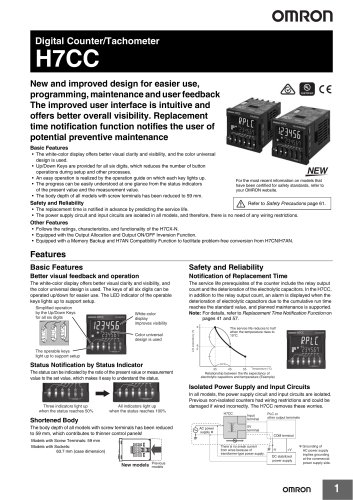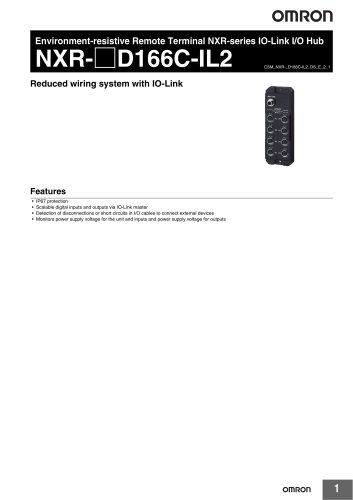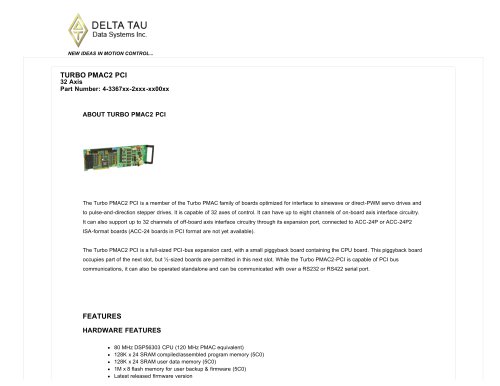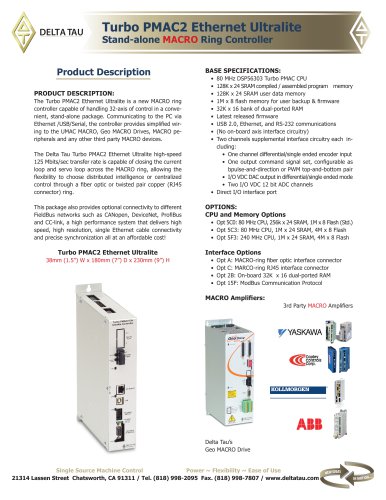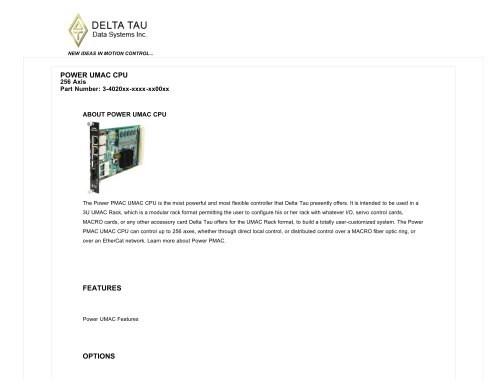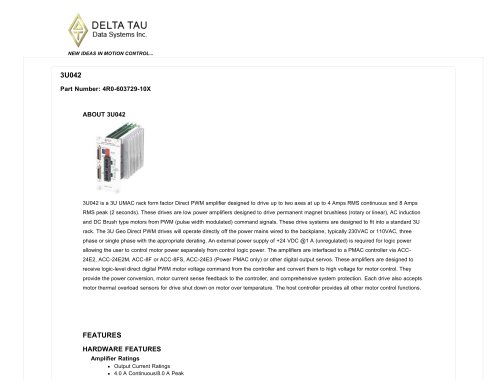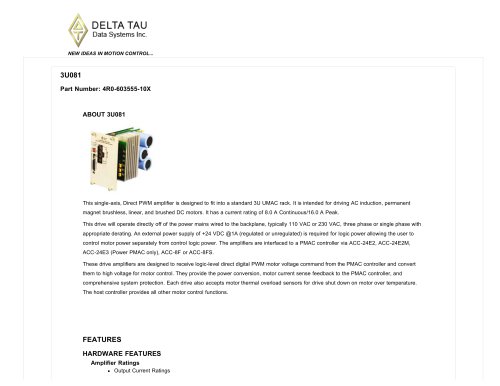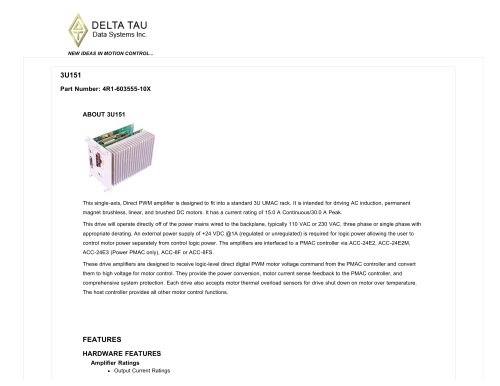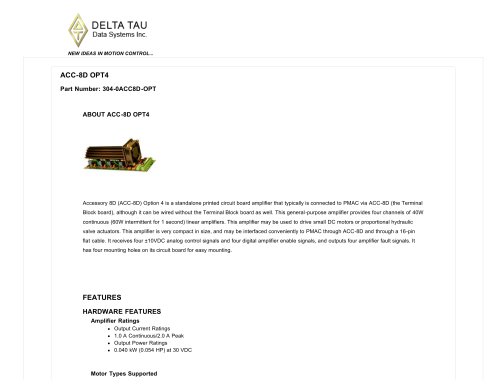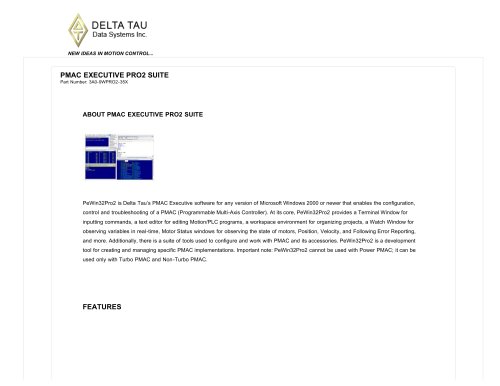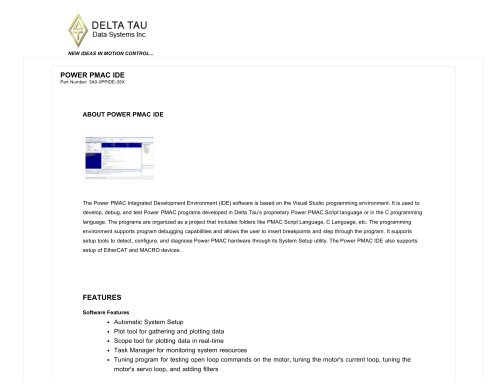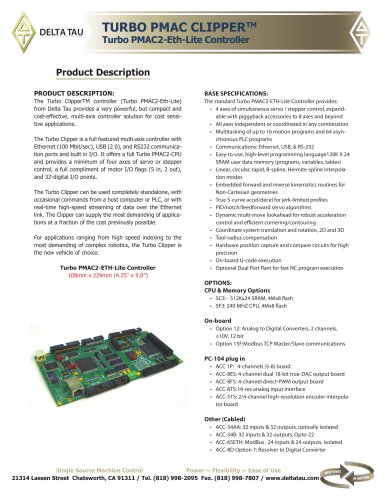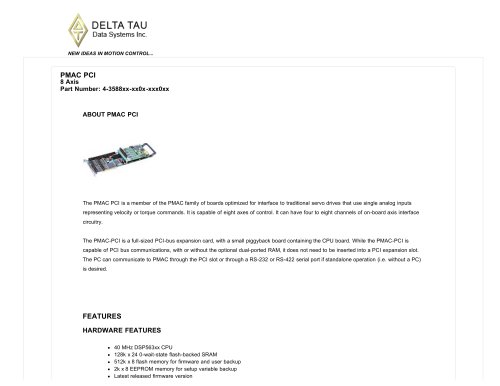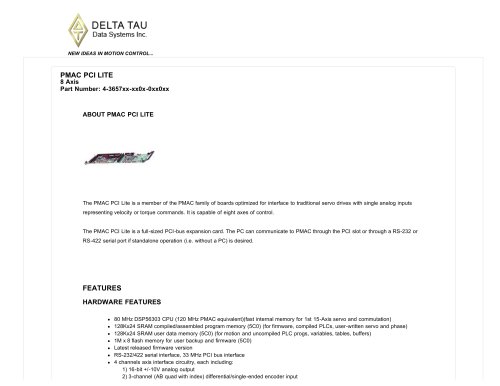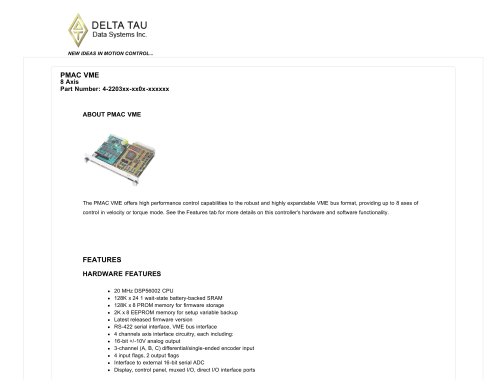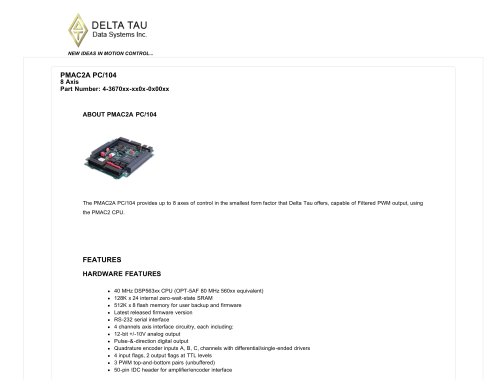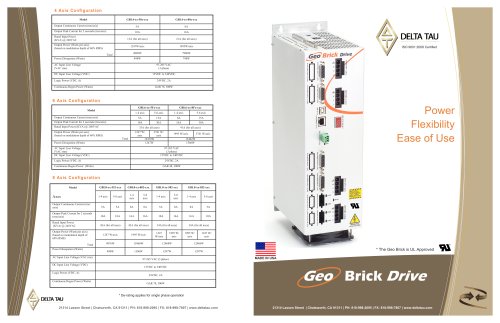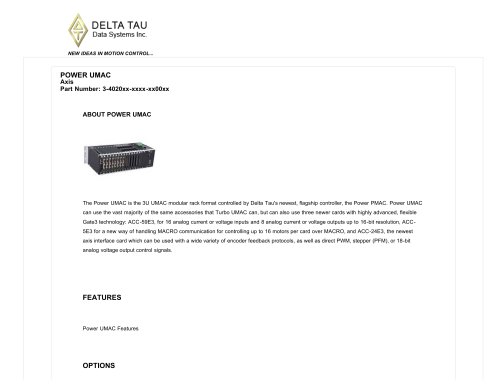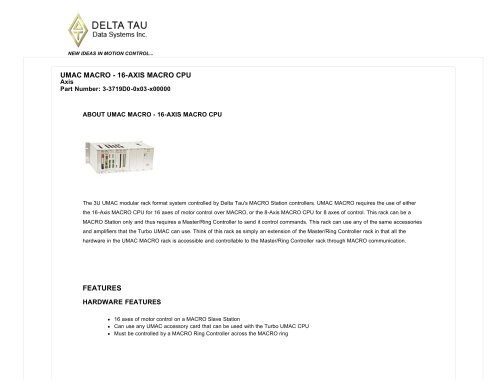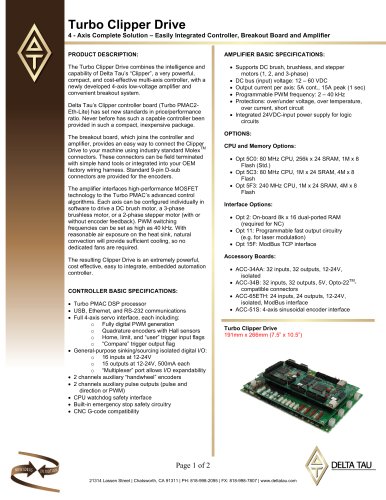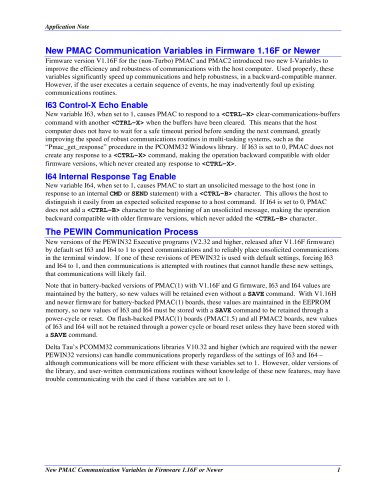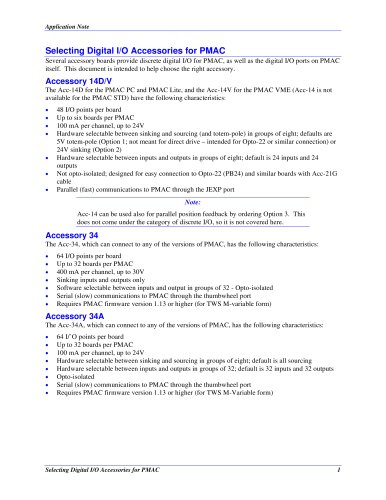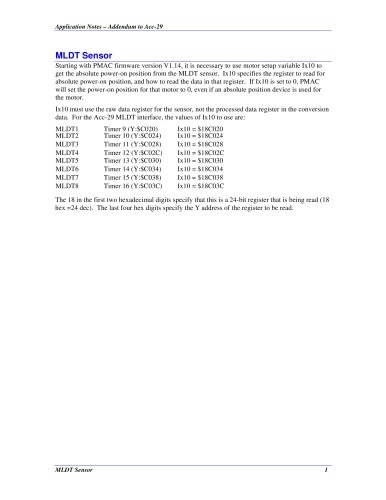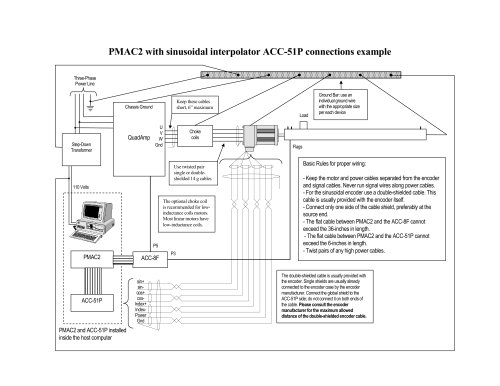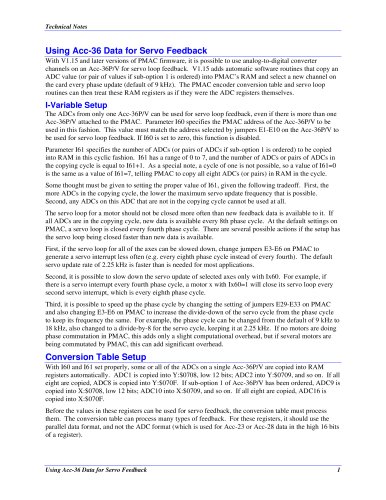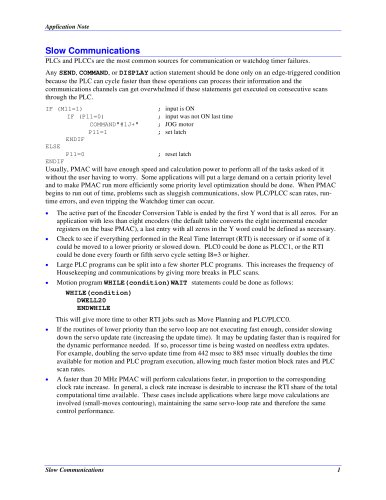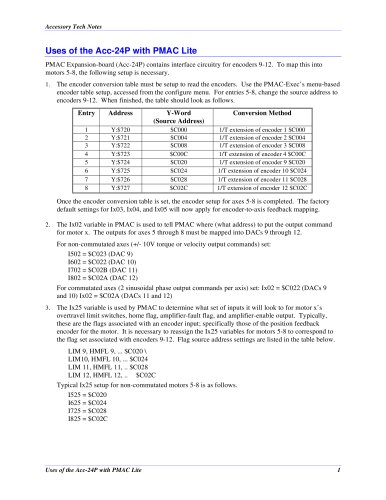 Website:
Delta Tau
Website:
Delta Tau
Catalog excerpts

Application Note PMAC boards utilize small lithium batteries to retain user programs and buffers in PMAC memory during periods when external power is not applied. The batteries come in two styles: a 2/3 A-size battery on older versions of the PMAC PC and PMAC VME, or a can-stack battery on all other versions of PMAC. This note covers several issues regarding the batteries that may be of concern to PMAC customers. > The PMAC batteries contain a lithium metal anode and a carbon cathode which are separated by a non- woven glass fiber separator. These are contained in a stainless steel casing with a thionyl chloride (SOCl2) electrolyte. There are no heavy metals used in the casing or active components: no mercury, no lead, and no cadmium. The average open-circuit voltage is 3.7V. The electrochemical reactions are: Anode: 4Li = 4Li+ + 4e Cathode: 2SOCl2 + 4e > - = SO2 +4Cl > - + S Net: 4Li + 2SOCl2 = 4LiCl + SO2 +S > The chemistry used in lithium batteries has at least the theoretical potential of explosion under some circumstances. The battery manufacturers that Delta Tau uses for PMAC have taken great care that this will not happen. The batteries used in PMAC have Underwriters Laboratory (UL) certification. As the most prominent safety testing body in the United States, UL performs extensive testing of equipment under both normal and abusive conditions. For batteries, this includes prolonged short-circuit testing. The PMAC batteries survived the short-circuit test without failure җ test results indicate a 1A current draw and 25C temperature rise under these conditions, well within design specifications. > Some institutions place restrictions on the air transport of some large lithium batteries. The United States Department of Transportation (USDOT) exempts all lithium batteries that contain less than one-half gram of lithium from any restrictions. The batteries used in PMAC fall into this category, and so are exempt from any USDOT restrictions on air transport. Even so, these batteries have passed the testing procedure used to certify larger lithium batteries as safe for all types of air transport. These tests include low pressure testing to 15,000 m (50,000 ft) equivalent, shock, vibration, and temperature testing. > Some localities consider used lithium batteries from industrial use to be hazardous waste, and therefore illegal to dispose with normal refuse. Companies should check with local, state, and national disposal regulations for proper methods of disposal. Neither Delta Tau nor the battery manufacturer is aware of any lithium battery recycling programs. Delta Tau will accept used batteries from PMAC customers at no charge to the customer. Customers interested in doing this should contact the factory for a Return Material Authorization (RMA) number before sending the batteries. A company specializing in battery disposal is BDT Inc. of Clarence, New York. Their phone number is (716) 634-6794; their fax number is (716) 634-6749. > The PMAC batteries have a capacity of 1 Ampere-hour (1 Ah). They are used to retain the contents of the three static RAM ICs on PMAC when 5V power is not present. There is no measurable current draw on the battery when 5V power is applied, so only PMAC off-time counts against battery life. The batteries have a conservatively rated shelf life of eight years, so they should not be counted on to provide power after this time, even if they have not been fully drained. > Battery with PMAC ISA 1 size="-1">
Open the catalog to page 1
Application Note The battery maintains the items stored in PMAC's static RAM. This includes all motion programs, both fixed (PROG) and rotary (ROT), PLC programs, leadscrew compensation buffers, data gathering buffers, P-Variable values, Q-Variable values, M-Variable definitions, and coordinate system axis definitions. All of these items, once loaded into PMAC, will be retained through power-up and power-down until changed (or until the battery fails). Most I-Variables are stored in EAROM during turn-off, and then copied into active memory on power-up. These values will be retained even if...
Open the catalog to page 3
Application Note To change a single battery on a PMAC with double sockets: 1. Remove PMAC from system if necessary to get access to battery. 2. Install the new battery in the open socket. 3. Remove the old battery from its socket 4. Move the battery jumper (E105 on PMAC Lite, E3 on the CPU board for PMAC PC or PMAC VME). If the battery is now installed in BAT1 or BT1 socket, the jumper should now connect pins 1 and 2 (bottom two pins) If the battery is now installed in BAT2 or BT2 socket, the jumper should now connect pins 2 and 3 (top two pins) 5. Re-install PMAC in the system and apply 5V...
Open the catalog to page 4
Application Note Replacement batteries may be ordered from Delta Tau or directly from a battery supplier. When ordering from Delta Tau, specify PMAC Acc-1L for the 2/3A-size battery (for older versions of the PMAC PC and PMAC VME), or PMAC Acc-1LS for the can-stack battery (for newer versions of the PMAC PC and PMAC VME, and all versions of the PMAC Lite and PMAC STD). When ordering from a manufacturer, specify the make of the battery directly. For the 2/3A-size battery, specify a lithium battery, 3.0V, 2/3A-size, no tabs, and usually 1200 mAh part number BR2/3A or compatible. For the...
Open the catalog to page 5All Delta Tau catalogs and technical brochures
-
Digital Counter/Tachometer H7CC
64 Pages
-
TURBO PMAC2 VME ULTRALITE
7 Pages
-
TURBO PMAC2 REALTIME EXPRESS
3 Pages
-
TURBO PMAC2 PCI
7 Pages
-
TURBO PMAC VME
6 Pages
-
POWER UMAC CPU 256 Axis
4 Pages
-
3U042
4 Pages
-
3U081
4 Pages
-
3U151
4 Pages
-
ACC-8D OPT4
3 Pages
-
ACC-8D OPT4A
3 Pages
-
ADVANTAGE 900 BASIC PACKAGE
3 Pages
-
PMAC MINI PCI 8 Axis
7 Pages
-
PMAC PCI 8 Axis
7 Pages
-
PMAC PCI LITE 8 Axis
7 Pages
-
PMAC VME 8 Axis
6 Pages
-
PMAC2A PC/104
6 Pages
-
POWER UMAC
4 Pages
-
TURBO UMAC
6 Pages
-
PMAC-NC PRO2 RUNTIME
3 Pages
-
Turbo Clipper Drive
2 Pages
-
Digital IO accessories
2 Pages
-
MLDT Sensor
1 Pages
-
Slow communications
1 Pages


